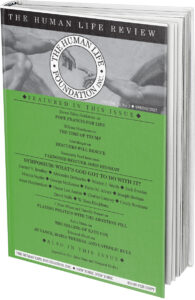The Blind Spot in Women’s Athletics
Just like their male counterparts, elite women athletes receive cutting-edge advice regarding diet, training, medicine, and sports psychology. It’s an approach meant to fine-tune game-day performance using the most up-to-date research. With competition for Olympic medals, championship trophies, and corporate endorsements being fiercer than ever, no big-time athlete—male or female—can afford to train the old-fashioned way.
Given the prevalence of scientific training methods, Olympic track-and-field star Sanya Richards-Ross made a stunning admission last month. Abortion, she claimed, was rampant among top-tier female athletes. “I literally don’t know another female track-and-field athlete who hasn’t had an abortion,” she said in an interview to promote her new book, Chasing Grace: What the Quarter Mile Has Taught Me about God and Life. “And that’s sad.” [http://www.telegraph.co.uk/athletics/2017/06/07/every-female-track-and-field-athlete-know-has-had-abortion-says/].
Richards-Ross herself had an abortion just prior to the 2008 Beijing Games, when she was 23. She’s 32 now, and haunted by regret. “I made a decision that broke me, and one from which I would not immediately heal,” she writes in the book. “Abortion would now forever be a part of my life. A scarlet letter I never thought I’d wear. I was a champion—and not just an ordinary one, but a world-class, record-breaking champion. From the heights of that reality I fell into a depth of despair.”
It’s not often you hear a woman—any woman—speak openly about the heartache that inevitably follows abortion. Just as rare, according to Richards-Ross—at least in the athletic world—is any straight talk about a woman’s reproductive system. The detail-oriented, science-informed training regimens elite athletes have come to expect simply ignore fertility.
“The truth is it’s an issue that’s not really talked about, especially in sports,” Richards-Ross recently told Sports Illustrated’s daily online talk show, SI Now. “At that time in your life, when you’re in college, you don’t feel comfortable talking to your mom. So a lot of the information you get is from your peers.”
The information Richards-Ross did absorb was far from scientific. “It’s going to sound silly to some people,” she went on, “but in [the female athletic] community people don’t want to take the pill because you put water weight on. And then people tell you that when you’re extremely fit you can’t get pregnant because our [menstrual] cycles are shorter. So, there’s a lot of miseducation that happens to young women in college, because we’re educating ourselves.”
It’s a solid bet that no college coach would allow athletes to “educate themselves” with regard to diet, hydration, sleep, and physical training. Yet if Richards-Ross is to be believed, and there’s no reason to think she shouldn’t be, elite female athletes are coached on every aspect of their body’s performance except reproduction—when they can get pregnant and when they can’t.
Athletes are notoriously picky about what they put into their bodies. Fortunately, there’s a non-chemical, reliable method of birth control that’s readily available and easily explainable to trainers and athletes. All they need to do is contact any Catholic church in America. Natural Family Planning experts would be more than happy to share what they know.
NFP is mocked in some circles—as are gluten-free diets and cupping therapy—but it is a proven method of birth control that does not involve altering or interrupting a woman’s hormonal cycles. It relies on her tracking physical signs and symptoms throughout the month, not unlike the way athletes are expected to log their nutrition and training details.
At the very least, a non-Catholic-based book like Taking Charge of Your Fertility by Toni Weschler could sit in women’s collegiate athletics offices around the country. Nor would it kill coaches to have a woman’s health expert talk to athletes a couple of times a year about the female reproductive system and the critical influence diet and exercise have on it.
Why such mystery over a basic fact of female physiology? A couple hundred thousand years of the exact same thing happening to all women everywhere should have been enough to wipe away the dopey shame that still accompanies the onset of menstruation in young girls.
Who stands to profit from shame and misinformation? Big Abortion, for sure. Confusion keeps the abortion mills busy. Confusion is also the goal of anti-ultrasound activists who don’t want women seeing images of their unborn children. Ignorance, fostered by talk of “a clump of cells,” creates customers for Planned Parenthood.
But even from a strictly selfish point of view, shouldn’t the big women’s sports associations—e.g., the NCAA and the U.S. Olympic Committee—want all their athletes to be aware of the basic facts of life? After all, Richards-Ross said that her abortion, which happened the day before she got on a plane to Beijing, threw her into a mental tailspin. Pricey, new-age-psychology tips are useless in combatting a setback like that.
Of course, the big elephant in the room remains. If getting pregnant would derail all your hopes and dreams, there’s one foolproof way to avoid it: Don’t have sex. Everyone knows that and always has. The difference is that modern women are supposed to have more control over when and how it happens than women of earlier eras did. Apparently that is often not the case.
Richards-Ross, now retired and pregnant, told SI Now she’s determined to try to change things by being honest about her own abortion and the regret she feels. “So, for me, I’m hoping that this will open up some discussions, to helping especially a lot of young women who were in my situation not experience what I did.”










Unfortunately, some of the information that is out there promotes abortion. The Soviets did experiments on female athletes in regards to pregnancy hormones being beneficial to athletic development. They liked the results they got, but there was a problem: pregnancy in later months hindered athletic development, and labor/delivery and babies really hindered athletic development. Their solution: abortion.